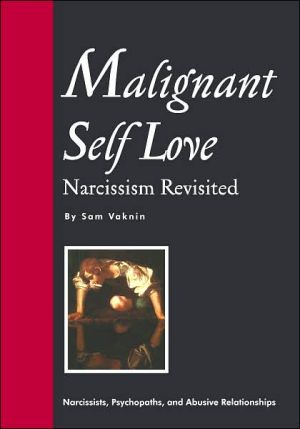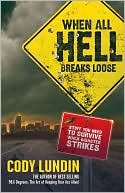Malignant Self Love: Narcissism Revisited
You are not alone! \ Are YOU Abused? Stalked? Harassed? Victimized? Confused and Frightened? Were you brought up by a Narcissistic or Psychopathic Parent? Married to a Narcissist or a Psychopath - or Divorcing One? Afraid your children will turn out to be narcissists or psychopaths? Want to cope with this pernicious, baffling condition?\ OR: Are You a Narcissist or a Psychopath - or suspect that You may be one ...\ This book will teach you how to Cope, Survive, and Protect Your Loved Ones!\...
Search in google:
You are not alone! Are YOU Abused? Stalked? Harassed? Victimized? Confused and Frightened? Were you brought up by a Narcissistic or Psychopathic Parent? Married to a Narcissist or a Psychopath - or Divorcing One? Afraid your children will turn out to be narcissists or psychopaths? Want to cope with this pernicious, baffling condition? OR: Are You a Narcissist or a Psychopath - or suspect that You may be one ... This book will teach you how to Cope, Survive, and Protect Your Loved Ones! "Malignant Self-love: Narcissism Revisited" is based on correspondence since 1996 with hundreds of people diagnosed with Narcissistic and Antisocial Personality Disorders (narcissists and psychopaths) and with thousands of their suffering family members, friends, therapists, and colleagues. The first ever book about narcissistic abuse, Malignant Self-love: Narcissism Re-Visited offers a detailed, first hand account of what it is like to have a Narcissistic Personality Disorder. It contains new insights and an organized methodological framework. The first part of the book comprises more than 100 Frequently Asked Questions (FAQs) regarding relationships with abusive narcissists and the Narcissistic Personality Disorder. What is a personality disorder? When the personality is rigid to the point of being unable to change in reaction to changing circumstances - we say that it is disordered. Such a person takes behavioral, emotional, and cognitive cues exclusively from others. His inner world is, so to speak, vacated. His True Self is dilapidated and dysfunctional. Instead he has a tyrannical and delusional False Self. Such a person is incapable of loving and of living. He cannot love others because he cannot love himself. He loves his reflection, his surrogate self. And he is incapable of living because life is a struggle towards, a striving, a drive at something. In other words: life is change. He who cannot change cannot live. The narcissist is an actor in a monodrama, yet forced to remain behind the scenes. The scenes take center stage, instead. The Narcissist does not cater at all to his own needs. Contrary to his reputation, the Narcissist does not "love" himself in any true sense of the word. He feeds off other people, who hurl back at him an image that he projects to them. This is their sole function in his world: to reflect, to admire, to applaud, to detest - in a word, to assure him that he exists. Otherwise, the narcissist feels, they have no right to tax his time, energy, or emotions. The posting of Malignant Self Love - Narcissism Re-Visited on the Web has elicited a flood of excited, sad and heart rending responses, mostly from victims of Narcissists but also from people suffering from the NPD. This is a true picture of the resulting correspondence with them. This book is not intended to please or to entertain. NPD is a pernicious, vile and tortuous disease, which affects not only the Narcissist. It infects and forever changes people who are in daily contact with the Narcissist. In other words: it is contagious. It is my contention that Narcissism is the mental epidemic of the twentieth century, a plague to be fought by all means. This tome is my contribution to minimizing the damages of this disorder. Inscriptions Magazine - Katherine Theriault "...This book has an important purpose. I am sure it will be appreciated in a library,classroom or among the mental health profession. "
Question: What kind of a spouse/mate/partner is likely to be attracted to a narcissist?\ Answer:\ The Victims\ On the face of it, there is no (emotional) partner or mate, who typically "binds" with a narcissist. They come in all shapes and sizes. The initial phases of attraction, infatuation and falling in love are pretty normal. The narcissist puts on his best face — the other party is blinded by budding love. A natural selection process occurs only much later, as the relationship develops and is put to the test.\ Living with a narcissist can be exhilarating, is always onerous, often harrowing. Surviving a relationship with a narcissist indicates, therefore, the parameters of the personality of the survivor. She (or, more rarely, he) is moulded by the relationship into The Typical Narcissistic Mate/Partner/Spouse.\ First and foremost, the narcissist's partner must have a deficient or a distorted grasp of her self and of reality. Otherwise, she (or he) is bound to abandon the narcissist's ship early on. The cognitive distortion is likely to consist of belittling and demeaning herself — while aggrandising and adoring the narcissist. The partner is, thus, placing himself in the position of the eternal victim: undeserving, punishable, a scapegoat. Sometimes, it is very important to the partner to appear moral, sacrificial and victimised. At other times, she is not even aware of this predicament. The narcissist is perceived by the partner to be a person in the position to demand these sacrifices from her partner, being superior in many ways (intellectually, emotionally, morally, financially).\ The status of professional victim sits well with the partner's tendency to punish herself, namely: with her masochistic streak. The tormented life with the narcissist is, as far as the partner is aware, a just punitive measure.\ In this respect, the partner is the mirror image of the narcissist. By maintaining a symbiotic relationship with him, by being totally dependent upon the source of masochistic supply (which the narcissist most reliably constitutes and most amply provides) — the partner enhances certain traits and encourages certain behaviours, which are at the very core of narcissism.\ The narcissist is never whole without an adoring, submissive, available, self-denigrating partner. His very sense of superiority, indeed his False Self, depends on it. His sadistic Superego switches its attentions from the narcissist (in whom it often provokes suicidal ideation) to the partner, thus finally obtaining an alternative source of sadistic satisfaction.\ It is through self-denial that the partner survives. She denies her wishes, hopes, dreams, aspirations, sexual, psychological and material needs, and much else besides. She perceives her needs as threatening because they might engender the wrath of the narcissist's God-like supreme figure. The narcissist is rendered in her eyes even more superior through and because of this self-denial. Self-denial undertaken to facilitate and ease the life of a "great man" is more palatable. The "greater" the man (=the narcissist), the easier it is for the partner to ignore her own self, to dwindle, to degenerate, to turn into an appendix of the narcissist and, finally, to become nothing but an extension, to merge with the narcissist to the point of oblivion and of dim memories of one's self.\ The two collaborate in this macabre dance. The narcissist is formed by his partner inasmuch as he forms her. Submission breeds superiority and masochism breeds sadism. The relationships are characterised by rampant emergentism: roles are allocated almost from the start and any deviation meets with an aggressive, even violent reaction.\ The predominant state of the partner's mind is utter confusion. Even the most basic relationships — with husband, children, or parents — remain bafflingly obscured by the giant shadow cast by the intensive interaction with the narcissist. A suspension of judgement is part and parcel of a suspension of individuality, which is both a prerequisite to and the result of living with a narcissist. The partner no longer knows what is true and right and what is wrong and forbidden.\ The narcissist recreates for the partner the sort of emotional ambience that led to his own formation in the first place: capriciousness, fickleness, arbitrariness, emotional (and physical or sexual) abandonment. The world becomes uncertain and frightening and the partner has only one thing to cling to: the narcissist.\ And cling she does. If there is anything which can safely be said about those who emotionally team up with narcissists, it is that they are overtly and overly dependent.\ The partner doesn't know what to do — and this is only too natural in the mayhem that is the relationship with the narcissist. But the typical partner also does not know what she wants and, to a large extent, who she is and what she wants to become.\ These unanswered questions hamper the partner's ability to gauge reality, evaluate and appraise it for what it is. Her primordial sin is that she fell in love with an image, not with a real person. It is the voiding of the image that is mourned when the relationship ends.\ The break-up of a relationship with a narcissist is, therefore, very emotionally charged. It is the culmination of a long chain of humiliations and of subjugation. It is the rebellion of the functioning and healthy parts of the partner's personality against the tyranny of the narcissist.\ The partner is liable to have totally misread and misinterpreted the whole interaction (I hesitate to call it a relationship). This lack of proper interface with reality might be (erroneously) labelled "pathological".\ Why is it that the partner seeks to prolong her pain? What is the source and purpose of this masochistic streak? Upon the break-up of the relationship, the partner (and the narcissist) engage in a tortuous and drawn out post mortem. But the question who really did what to whom (and even why) is irrelevant. What is relevant is to stop mourning oneself (this is what the parties are really mourning), start smiling again and love in a less subservient, hopeless, and pain-inflicting manner.\ The Abuse\ Abuse is an integral, inseparable part of the Narcissistic Personality Disorder.\ The narcissist idealises and then DEVALUES and discards the object of his initial idealisation. This abrupt, heartless devaluation IS abuse. ALL narcissists idealise and then devalue. This is THE core of narcissistic behaviour. The narcissist exploits, lies, insults, demeans, ignores (the "silent treatment"), manipulates, controls. All these are forms of abuse.\ There are a million ways to abuse. To love too much is to abuse. It is tantamount to treating someone as one's extension, an object, or an instrument of gratification. To be over-protective, not to respect privacy, to be brutally honest, with a morbid sense of humour, or consistently tactless — is to abuse. To expect too much, to denigrate, to ignore — are all modes of abuse. There is physical abuse, verbal abuse, psychological abuse, sexual abuse. The list is long.\ Narcissists are masters of abusing surreptitiously. They are "stealth abusers". You have to actually live with one in order to witness the abuse.\ There are three important categories of abuse:\ 1. Overt Abuse — The open and explicit abuse of another person. Threatening, coercing, beating, lying, berating, demeaning, chastising, insulting, humiliating, exploiting, ignoring ("silent treatment"), devaluing, unceremoniously discarding, verbal abuse, physical abuse and sexual abuse are all forms of overt abuse.\ 2. Covert or Controlling Abuse — Narcissism is almost entirely about control. It is a primitive and immature reaction to the circumstances of a llife in which the narcissist (usually in his childhood) was rendered helpless. It is about re-asserting one's identity, re-establishing predictability, mastering the environment — human and physical.\ 3. The bulk of narcissistic behaviours can be traced to this panicky reaction to the remote potential for loss of control. Narcissists are hypochondriacs (and difficult patients) because they are afraid to lose control over their body, its looks and its proper functioning. They are obsessive-compulsive in their efforts to subdue their physical habitat and render it foreseeable. They stalk people and harass them as a means of "being in touch" — another form of narcissistic control.\ But why the panic?\ The narcissist is a solipsist. To him, nothing exists except himself. Meaningful others are his extensions, assimilated by him, internal objects — not external ones. Thus, losing control of a significant other — is equivalent losing the use of a limb, or of one's brain. It is terrifying.\ Independent or disobedient people evoke in the narcissist the realisation that something is wrong with his worldview, that he is not the centre of the world or its cause and that he cannot control what, to him, are internal representations.\ To the narcissist, losing control means going insane. Because other people are mere elements in the narcissist's mind — being unable to manipulate them literally means losing it (his mind). Imagine, if you suddenly were to find out that you cannot manipulate your memories or control your thoughts... Nightmarish!\ Moreover, it is often only through manipulation and extortion that the narcissist can secure his Narcissistic Supply. Controlling his Sources of Narcissistic Supply is a (mental) life or death question for the narcissist. The narcissist is a drug addict (his drug being the NS) and he would go to any length to obtain the next dose.\ In his frantic efforts to maintain control or re-assert it, the narcissist resorts to a myriad of fiendishly inventive stratagems and mechanisms. Here is a partial list:\ Unpredictability\ The narcissist acts unpredictably, capriciously, inconsistently and irrationally. This serves to demolish in others their carefully crafted worldview. They become dependent upon the next twist and turn of the narcissist, his inexplicable whims, his outbursts, denial, or smiles. In other words: the narcissist makes sure that HE is the only stable entity in the lives of others — by shattering the rest of their world through his seemingly insane behaviour. He guarantees his presence in their lives — by destabilising them.\ In the absence of a self, there are no likes or dislikes, preferences, predictable behaviour or characteristics. It is not possible to know the narcissist. There is no one there.\ The narcissist was conditioned — from an early age of abuse and trauma — to expect the unexpected. His was a world in which (sometimes sadistic) capricious caretakers and peers often behaved arbitrarily. He was trained to deny his True Self and nurture a False one.\ Having invented himself, the narcissist sees no problem in re-inventing that which he designed in the first place. The narcissist is his own creator.\ Hence his grandiosity.\ Moreover, the narcissist is a man for all seasons, forever adaptable, constantly imitating and emulating, a human sponge, a perfect mirror, a chameleon, a non-entity that is, at the same time, all entities combined. The narcissist is best described by Heidegger's phrase: "Being and Nothingness". Into this reflective vacuum, this sucking black hole, the narcissist attracts the Sources of his Narcissistic Supply.\ To an observer, the narcissist appears to be fractured or discontinuous.\ Pathological narcissism has been compared to the Dissociative Identity Disorder (formerly the Multiple Personality Disorder). By definition, the narcissist has at least two selves, the True and False ones. His personality is very primitive and disorganised. Living with a narcissist is a nauseating experience not only because of what he is — but because of what he is NOT. He is not a fully formed human — but a dizzyingly kaleidoscopic gallery of ephemeral images, which melt into each other seamlessly. It is incredibly disorienting.\ It is also exceedingly problematic. Promises made by the narcissist are easily disowned by him. His plans are transient. His emotional ties — a simulacrum. Most narcissists have one island of stability in their life (spouse, family, their career, a hobby, their religion, country, or idol) — pounded by the turbulent currents of a dishevelled existence.\ The narcissist does not keep agreements, does not adhere to laws, regards consistency and predictability as demeaning traits.\ Thus, to invest in a narcissist is a purposeless, futile and meaningless activity. To the narcissist, every day is a new beginning, a hunt, a new cycle of idealisation or devaluation, a newly invented self. There is no accumulation of credits or goodwill because the narcissist has no past and no future. He occupies an eternal and timeless present. He is a fossil caught in the frozen ashes of a volcanic childhood.\ What to do?\ Refuse to accept such behaviour. Demand reasonably predictable and rational actions and reactions. Insist on respect for your boundaries, predilections, preferences, and priorities.\ Disproportional Reactions\ One of the favourite tools of manipulation in the narcissist's arsenal is the disproportionality of his reactions. He reacts with supreme rage to the slightest slight. He punishes severely for what he perceives to be an offence against him, no matter how minor. He throws a temper tantrum over any discord or disagreement, however gently and considerately expressed. Or he may act attentive, charming and tempting (even over-sexed, if need be). This ever-shifting code of conduct coupled with an inordinately harsh and arbitrarily applied "penal code" are both promulgated by the narcissist. Neediness and dependence on the source of all justice meted — on the narcissist — are thus guaranteed.\ What to do?\ Demand a just and proportional treatment. Reject or ignore unjust and capricious behaviour.\ If you are up to the inevitable confrontation, react in kind. Let him taste some of his own medicine.\ Dehumanisation and Objectification\ People have a need to believe in the empathic skills and basic good-heartedness of others. By dehumanising and objectifying people — the narcissist attacks the very foundations of the social treaty. This is the "alien" aspect of narcissists — they may be excellent imitations of fully formed adults but they are emotionally non-existent, or, at best, immature.\ This is so horrid, so repulsive, so phantasmagoric — that people recoil in terror. It is then, with their defences absolutely down, that they are the most susceptible and vulnerable to the narcissist's control. Physical, psychological, verbal and sexual abuse are all forms of dehumanisation and objectification.\ What to do?\ Never show your abuser that you are afraid of him. Do not negotiate with bullies. They are insatiable. Do not succumb to blackmail.\ If things get rough- disengage, involve law enforcement officers, friends and colleagues, or threaten him (legally).\ Do not keep your abuse a secret. Secrecy is the abuser's weapon.\ Never give him a second chance. React with your full arsenal to the first transgression.\ Abuse of Information\ From the first moments of an encounter with another person, the narcissist is on the prowl. He collects information with the intention of applying it later to extract Narcissistic Supply. The more he knows about his potential Source of Supply — the better able he is to coerce, manipulate, charm, extort or convert it "to the cause". The narcissist does not hesitate to abuse the information he gleaned, regardless of its intimate nature or the circumstances in which he obtained it. This is a powerful tool in his armoury.\ What to do?\ Be guarded. Don't be too forthcoming in a first or casual meeting. Gather intelligence.\ Be yourself. Don't misrepresent your wishes, boundaries, preferences, priorities, and red lines.\ Do not behave inconsistently. Do not go back on your word. Be firm and resolute.\ Impossible Situations\ The narcissist engineers impossible, dangerous, unpredictable, unprecedented, or highly specific situations in which he is sorely and indispensably needed. The narcissist, his knowledge, his skills or his traits become the only ones applicable, or the most useful to coping with these artificial predicaments. It is a form of control by proxy.\ What to do?\ Stay away from such quagmires. Scrutinise every offer and suggestion, no matter how innocuous.\ Prepare backup plans. Keep others informed of your whereabouts and appraised of your situation.\ Be vigilant and doubting. Do not be gullible and suggestible. Better safe than sorry.\ Control by Proxy\ If all else fails, the narcissist recruits friends, colleagues, mates, family members, the authorities, institutions, neighbours, or the media — in short, third parties — to do his bidding. He uses them to cajole, coerce, threaten, stalk, offer, retreat, tempt, convince, harass, communicate and otherwise manipulate his target. He controls these unaware instruments exactly as he plans to control his ultimate prey. He employs the same mechanisms and devices. And he dumps his props unceremoniously when the job is done.\ Another form of control by proxy is to engineer situations in which abuse is inflicted upon another person. Such carefully crafted scenarios involve embarrassment and humiliation as well as social sanctions (condemnation, opprobrium, or even physical punishment). Society, or a social group become the instruments of the narcissist.\ What to do?\ Often the abuser's proxies re unaware of their role. Expose him. Inform them. Demonstrate to them how they are being abused, misused, and plain used by the abuser.\ Trap your abuser. Treat him as he treats you. Involve others. Bring it into the open. Nothing like sunshine to disinfest abuse.\ Ambient Abuse\ The fostering, propagation and enhancement of an atmosphere of fear, intimidation, instability, unpredictability and irritation. There are no acts of traceable or provable explicit abuse, nor any manipulative settings of control. Yet, the irksome feeling remains, a disagreeable foreboding, a premonition, a bad omen. This is sometimes called "gaslighting". In the long-term, such an environment erodes one's sense of self-worth and self-esteem. Self-confidence is shaken badly. Often, the victims go a paranoid or schizoid and thus are exposed even more to criticism and judgement. The roles are thus reversed: the victim is considered mentally disordered and the narcissist — the suffering soul.\ What to do?\ Run! Get away! Ambient abuse often develops to overt and violent abuse.\ You don't owe anyone an explanation — but you owe yourself a life. Bail out.\ The Malignant Optimism of the Abused\ I often come across sad examples of the powers of self-delusion that the narcissist provokes in his victims. It is what I call "malignant optimism". People refuse to believe that some questions are unsolvable, some diseases incurable, some disasters inevitable. They see a sign of hope in every fluctuation. They read meaning and patterns into every random occurrence, utterance, or slip. They are deceived by their own pressing need to believe in the ultimate victory of good over evil, health over sickness, order over disorder. Life appears otherwise so meaningless, so unjust and so arbitrary...\ So, they impose upon it a design, progress, aims, and paths. This is magical thinking.\ "If only he tried hard enough", "If he only really wanted to heal", "If only we found the right therapy", "If only his defences were down", "There MUST be something good and worthy under the hideous facade", "NO ONE can be that evil and destructive", "He must have meant it differently", "God, or a higher being, or the spirit, or the soul is the solution and the answer to our prayers".\ The Pollyanna defences of the abused against the emerging and horrible understanding that humans are specks of dust in a totally indifferent universe, the playthings of evil and sadistic forces, of which the narcissist is one. And that finally their pain means nothing to anyone but themselves. Nothing whatsoever. It has all been in vain.\ The narcissist holds such thinking in barely undisguised contempt. To him, it is a sign of weakness, the scent of prey, a gaping vulnerability. He uses and abuses this human need for order, good, and meaning — as he uses and abuses all other human needs. Gullibility, selective blindness, malignant optimism — these are the weapons of the beast. And the abused are hard at work to provide it with its arsenal.
ForewordPrologueIntroduction - The Habit of IdentityThe Narcissistic Personality DisorderA Primer on Narcissism and the Narcissistic Personality Disorder (NPD)Bibliography Frequently Asked QuestionsNarcissism - The DisorderFAQ # 1 - An Overview of the NarcissistFAQ # 2 - Pathological Narcissism – A Dysfunction or a Blessing?FAQ # 3 - The Energy of SelfFAQ # 4 - Self-Love and NarcissismFAQ # 5 - Self-Defeating and Self-Destructive BehavioursFAQ # 6 - Ideas of ReferenceFAQ # 7 - Grandiose FantasiesFAQ # 8 - Grandiosity Hangover and Narcissist BaitingFAQ # 9 - Depression and the NarcissistFAQ # 10 - Narcissistic Rage - Anger as a Source of Personality DisorderFAQ # 11 - Gender and the NarcissistFAQ # 12 - Homosexual and Transsexual NarcissistsFAQ # 13 - Addiction to Fame and CelebrityFAQ # 14 - Conspicuous ExistenceFAQ # 15 - The Narcissist's Reaction to Deficient Narcissistic SupplyFAQ # 16 - The Delusional Way OutFAQ # 17 - The Compulsive Acts of the NarcissistFAQ # 18 - Narcissistic RoutinesFAQ # 19 - The Unstable NarcissistFAQ # 20 - Do Narcissists Have Emotions?FAQ # 21 - The Inappropriate AffectFAQ # 22 - The Ubiquitous NarcissistFAQ # 23 - The Narcissist as a SadistFAQ # 24 - Other People's PainFAQ # 25 - The Psychology of TortureFAQ # 26 - Multiple GrandiosityFAQ # 27 - False ModestyFAQ # 28 - Warped Reality and Retroactive Emotional ContentFAQ # 29 - Narcissistic Signal, Stimulus and Hibernation Mini-CyclesFAQ # 30 - The Narcissistic Pendulum and the Pathological Narcissistic SpaceFAQ # 31 - The Inanimate as a Source of Narcissistic Supply - Narcissistic Branding and Narcissistic ContagionFAQ # 32 - The Dual Role of the False SelfFAQ # 33 - The Stripped EgoFAQ # 34 - The Split-off EgoFAQ # 35 - The Serious NarcissistFAQ # 36 - Narcissists, Disagreements and CriticismFAQ # 37 - Transformations of AggressionFAQ # 38 - Narcissistic HumiliationFAQ # 39 - The Midlife NarcissistFAQ # 40 - To Age with GraceFAQ # 41 - The Narcissist and IntrospectionFAQ # 42 - The Losses of the NarcissistFAQ # 43 - Getting BetterFAQ # 44 - Can a Narcissist Help Himself?FAQ # 45 - Reconditioning the NarcissistFAQ # 46 - Treatment Modalities and TherapiesFAQ # 47 - Narcissistic MirroringFAQ # 48 - The Development of the NarcissistFAQ # 49 - The Narcissist's MotherFAQ # 50 - The Inverted NarcissistFAQ # 51 - Narcissists, Inverted Narcissists and SchizoidsFAQ # 52 - Narcissists, Medications and Chemical ImbalancesFAQ # 53 - Myths about NarcissismFAQ # 54 - The Selfish Gene – The Genetic Underpinnings of NarcissismFAQ # 55 - Narcissism – The Psychopathological DefaultFAQ # 56 - Narcissism, Other Mental Health Disorders, Substance Abuse, and Reckless Behaviours(Co-Morbidity and Dual Diagnosis)FAQ # 57 - Eating Disorders and the NarcissistFAQ # 58 - Can the Narcissist Have a Meaningful Life?FAQ # 59 - A Case Study of an Adolescent NarcissistFAQ # 60 - The Narcissist's Reaction to This Text Narcissism and SocietyFAQ # 61 - A Dream InterpretedFAQ # 62 - How to Recognise a Narcissist?FAQ # 63 - Interacting with a NarcissistFAQ # 64 - The Weapon of LanguageFAQ # 65 - Exploitation by a NarcissistFAQ # 66 - The Narcissist's VictimsFAQ # 67 - Narcissism by ProxyFAQ # 68 - Facilitating NarcissismFAQ # 69 - Narcissists in Positions of AuthorityFAQ # 70 - For the Love of GodFAQ # 71 - The Narcissist and Social InstitutionsFAQ # 72 - Collective Narcissism – Narcissism, Culture and SocietyFAQ # 73 - The Narcissists in CourtFAQ # 74 - The Narcissist in the WorkplaceFAQ # 75 - Responsibility and Other MattersFAQ # 76 - The Accountable NarcissistFAQ # 77 - Crime and Punishment: The Never Repenting NarcissistFAQ # 78 - Narcissists, Group Behaviour and TerrorismFAQ # 79 - Is the Narcissist Ever Sorry?FAQ # 80 - A Letter about TrustFAQ # 81 - Traumas as Social InteractionsFAQ # 82 - The Guilt of OthersFAQ # 83 - Narcissistic ConfinementFAQ # 84 - Narcissistic AllocationFAQ # 85 - Narcissistic ImmunityFAQ # 86 - Narcissists, Love and HealingFAQ # 87 - Vindictive NarcissistsFAQ # 88 - Narcissists as Mass and Serial KillersFAQ # 89 - Narcissists, Narcissistic Supply and Sources of Supply Narcissists and FamilyFAQ # 90 - How to Cope with a Narcissist?FAQ # 91 - Narcissists and WomenFAQ # 92 - The Spouse/Mate/Partner of the NarcissistFAQ # 93 - Investing in a NarcissistFAQ # 94 - The Double Reflection - Narcissistic Couples and Narcissistic TypesFAQ # 95 - Narcissistic ParentsFAQ # 96 - Narcissists and ChildrenFAQ # 97 - The Narcissist and His FamilyFAQ # 98 - Narcissists, Sex and Fidelity – The Somatic and the Cerebral NarcissistFAQ # 99 - The Extra-Marital NarcissistFAQ # 100 - Mourning the NarcissistFAQ # 101 - Surviving the NarcissistFAQ # 102 - The Dead Parents Guide to Coping with Your Abuser The Mind of the NarcissistChapter One - The Soul of a Narcissist – The State of the ArtChapter Two - Being SpecialChapter Three - Uniqueness and IntimacyChapter Four - The Workings of a Narcissist – A PhenomenologyChapter Five - The Tortured Self – The Inner World of the NarcissistChapter Six - The Emotional Involvement Preventive Measures
\ Sunday Times"Malignant Self-love (is a) ... magnum opus"--(Yvonne Roberts, September 16, 2007)\ \ \ \ \ Financial Times Weekend Magazine"Few people can claim to have increased the public awareness of NPD to such a degree."--(Adrian Tampany, September 4-5, 2010)\ \ \ Tim HallSam Vaknin is the world's leading expert on narcissism. He's also a narcissist himself. He was diagnosed with the illness in 1996 while serving a prison term in his native Israel. Before his imprisonment on fraud-related charges, Vaknin was an award-winning writer and an accomplished businessman. He is also well-educated, having earned a doctorate in philosophy.\ With his life in shambles, Vaknin attempted to understand the disorder that had come to define his existence. The result of this painful self-scrutiny and research was Malignant Self-Love: Narcissism Revisited (Narcissus Publications), an essential text on the subject of narcissism and a consistent top-seller at the Barnes & Noble website.\ — New York Press, Volume 16, Issue 7\ \ \ \ \ \ Ian Walker"Vaknin's a respected expert on malignant narcissists ... He set about to know everything there is about the psychopathic narcissist."\ —ABC Radio National Background Briefing, July 18, 2004\ \ \ \ \ From The Critics"The strength of this book comes from the author's vantage point: he is a Narcissist (with a capital N). He is an "insider", who discovered that he has the unbridled trait of narcissism and that this was the source of many of the difficulties in his professional and personal life. So we shall say at the outset that if you wish to get under the skin of a Narcissist (we shall call him the "N type"), if you wish to get to know how he thinks and feels and why he behaves as he does, then this is the book for you."\ —Sc.D., M.D. ,Mount Sinai Hospital, New York Author of "Towards Self and Sanity - On the Genetic Origins of the Human Character"\ \ \ \ \ Katherine Theriault"...This book has an important purpose. I am sure it will be appreciated in a library,classroom or among the mental health profession. "\ —Inscriptions Magazine\ \ \ \ \ Katherine Theriault...This book has an important purpose. I am sure it will be appreciated in a library,classroom or among the mental health profession. \ —Inscriptions Magazine, Vol. 2, Issue 20\ \







